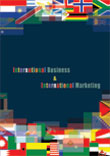International Business and International Marketing
 |
Details
Textbook:
Pages : 328;
Paperback;
210 X 275 mm approx.
Suggested Case Studies
Workbook:
Pages :
280; Paperback;
210 X 275 mm approx, Sample Applied Theory Questions
Sample Multiple Choice Questions (Online Quiz)
Pricing
Textbook Price: Rs. 750;
Workbook Price: Rs. 700;
Available only in INDIA
Buy Now
Please allow 5 to 10 days for delivery.
Detail Table of Contents
International Finance & Economics : Chapter 2
SUMMARY: Foreign exchange is a currency issued by a foreign government. It is required to pay for imported goods and to meet foreign debt repayment obligations. The exchange rate is the price of one currency in terms of another. Exchange rates are either fixed by governments or determined by the forces of demand and supply in the marketplace. Countries differ in the way they maintain their currency value in the foreign exchange market. In some countries, Central banks intervene in this process regularly while in others they don’t. Forecasting exchange rates is an important function of a corporate finance manager. Many corporations like Goldman Sachs, Citibank, Wharton Forecasting Services provide forecasts of various economic indicators including exchange rates. The models used for forecasting exchange rates can be classified into two: fundamental analysis models, and technical analysis models. |
|
Risk can be defined as uncertainty surrounding a particular event or item. Thus the changes in economic fundamentals, government policies, relationship between the trading countries are some risks specific to the international business community apart from general risks of changes in tastes and preferences of consumers, changes in technology, etc. Volatility in capital flows into and out of the financial markets can adversely affect the value of the domestic currency. Currency risk can be managed taking a short-term view and using financial instruments to hedge specific risks. A long-term strategic view of diversifying across products, markets and suppliers might involve more initial investment, but subsequently lower short-term hedging costs.
Financial instruments such as derivatives are used to minimize risk. Some of the common derivative instruments are: Forward contracts, Futures contracts. Options are relatively more sophisticated in terms of pricing and perhaps the most flexible of all instruments in terms of usage. Swaps are contracts between two parties, with or without an intermediary, to exchange interest payment obligations on domestic or international borrowings for a specified period of time so that the overall cost of funds for both the parties is reduced. Interest Rates Swaps (IRS) and Currency Swaps are the most prominent types of swaps. An Interest Rate Swap (IRS) is an agreement between two parties to exchange interest payment obligations of each other on a notional principal for a specified period of time. A Currency swap is a contract to exchange interest payments in one currency for those denominated in another currency. With the integration of world trade and the advent of new technology, world capital markets have started functioning more closely with each other. Capital markets are continuously innovating products and are structuring prices of products to suit customer needs. The markets for long-term instruments can be broadly classified into four main categories: Domestic markets for short and long term borrowing, Foreign markets for equity and debt, Euro currency markets, Foreign bond markets.
The BoP accounts of a country record the payments and receipts of the residents of the country in their transactions with residents of other countries. BoP is measured on quarterly and yearly basis. BoP is said to be favorable when receipts from foreigners exceed payments to them, and unfavorable when payments exceed receipts. Disequilibrium is caused by random variations in trade, fluctuations in production of primary goods such as agricultural goods. Disequilibrium in BoP can be of three types: Cyclical disequilibrium, Secular disequilibrium, and Structural disequilibrium. The 1990s saw some major changes in India's BoP position. In the beginning of the 1990s, the country witnessed a major crisis in BoP. India responded to the crisis by introducing a host of reforms which had a significant bearing on the BoP front. The late 1980s saw the beginning of trade liberalization in India. Import duties were reduced and investment opportunities for the private sector were widened. The 1991 economic reforms package further liberalized trade. India’s export performance in the post liberalisation period i.e. post 1991 has been much better than the pre-reform period. From a level of (–) 1.5% growth rate during 1991-92 the value of exports in dollar terms witnessed a growth rate of 21% in 2000-01.



